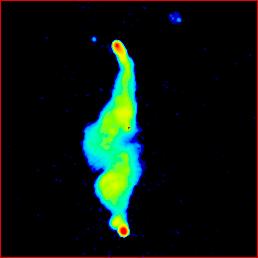 Image:
Image:3C 61.1 | B0210+860 |
| S178 | Alpha | FR | Class | ID | Spectrum | Best z | mag. | LAS | lg P178 | D |
|---|---|---|---|---|---|---|---|---|---|---|
| 34.0 | 0.77 | II | CD | Gal | 0.1860 | R = 18.43 | 186.00 | 26.27 | 497.0 |

| Size: | 256.0 × 256.0 arcsec² |
|---|---|
| LUT: | Logarithmic |
| Beam: | 3.7 arcsec |
| Frequency: | 1477 MHz |
| Method: | CLEAN Õ˜ÿ>3.7
|
| Telescope: | VLA B+C |
| Credits: | Leahy & Perley (1991) |
Also in the cluster (as confirmed by a similar redshift) is an optical AGN usually described as a quasar (Miller et al. 1973), although it is clearly a disk galaxy in archival HST images. This has caused much confusion in the literature because the quasar is often incorrectly labelled 3C 61.1 (or RN 8, which is another name for the DRAGN). In fact the quasar is 36 arcsec east of the DRAGN's host galaxy, well off the radio axis, and is radio quiet; so it seems to have no connection with the DRAGN. The quasar seems to be the source of the X-ray emission sometimes attributed to 3C 61.1, as shown by the high-resolution ROSAT image of Hardcastle & Worrall (1999). [Hardcastle & Worrall mark in their X-ray image the position not of the rather faint quasar, but of a bright star just to the south of it; otherwise the positional agreement between the quasar and X-ray source would be excellent!]
The bright hotspots have been imaged at high resolution by Dreher (1981) and Neff et al (1995).
There are two unrelated sources in the northern part of our
image, although perhaps the extended source to the NW is a head-tail galaxy
in the same cluster!
| Prev. | Data Page | Other images | Next | Search | Alphanumeric List | Icon List | Atlas Index |
|---|